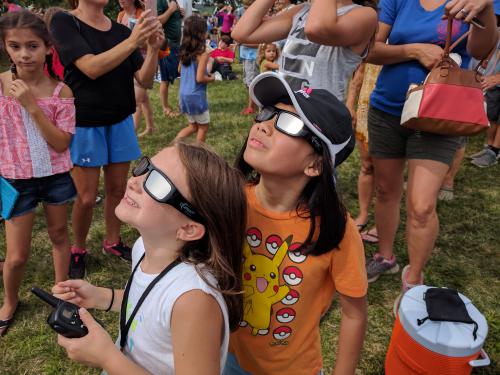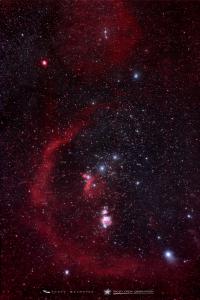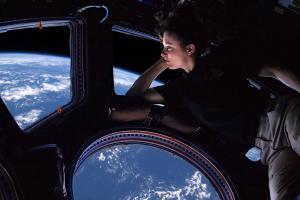Surviving Social Distancing
We are currently living in the reality of social distancing with isolation measures designed to curb a new contagion that posses a risk to much of the population. This has made life a bit difficult with the anxiety levels of many rising to new heights. Though we may not be able to visit our favorite coffee shops, restaurants, or chill at the mall, we can still step outside as often as possible to celebrate the natural world. You may not have the amazing starscape that blazes the sky over Frosty Drew Observatory, but there are so many things you can do at home to stay connected to space. Below we are posting a list of activities that you can do at home to help keep you looking to the sky. We believe that during this difficult and rapidly changing situation we can take solace in the cosmos, the night sky, and the natural world. So take a moment and read up on how you can stay connected to the cosmos while stuck at home.
Remember that crazy awesome Solar Eclipse that happened in August 2017? The one that brought upwards of 4,000 visitors to Frosty Drew Observatory. Of all the things that happened that day, the craze of Eclipse Glasses is certainly one of my top 5 memories. If you still have your Eclipse Glasses and they are in okay condition, they can be used to observe the Sun on any clear(er) day. Do this:
Step outside with your eclipse glasses, hold them to your face and look around (not at the Sun). If you see any cracks where light is coming through or any specs of light coming through the tinted lenses, then they are NOT SAFE to use. Here is additional information about qualifying eclipse glasses. If the glasses pass these tests, you can use them. Grab a lawn chair, recline a bit, put on your eclipse glasses and sit back to observe the Sun. The Sun is currently in a record setter Solar Minimum, so you will likely not see any sunspots. Though it’s always impressive to observe a star from such a close distance. Note, do not use binoculars or a telescope when wearing eclipse glasses, they are for direct viewing only. Also, do not look directly at the Sun, ever, without proper eye protection in place. If you are looking to purchase Eclipse Glasses, these are from a reputable company (Rainbow Symphony).
If you have a telescope with a computer (goto telescope), then you can set up your telescope during the daytime and observe Venus in broad daylight. Venus is currently sporting a stunning 53% waning gibbous phase, almost Third Quarter. Currently, Venus is about 45º east of the Sun in the sky, making for excellent daytime viewing opportunities. The reason we recommend using a goto telescope is due to the increased possibility of accidentally directing the telescope towards the Sun. Daytime Venus spotting is a fabulous activity, but it is also a little risky considering the Sun is above the horizon. Be sure to put 100% of your attention into where your telescope is directed before looking into it. NEVER LOOK AT THE SUN IN AN UNFILTERED TELESCOPE!
If your telescope is not computerized, you can use your smartphone with an astronomy app to find Venus. Set up your telescope so it is not facing the Sun! Open the astronomy app you use on your smartphone, confirm it has the correct date, time, and location, and set it up to abstract the sky (point the phone at the sky and have it tell you where you’re looking). Now place the back of your phone (palm side) against the back of the telescope diagonal so the back of the phone is perpendicular with the direction the telescope is looking. Then with the phone in that position, move the telescope until you are centered on Venus on the smartphone screen. This will get you very close to Venus. Now remove the smartphone from the telescope and look to the sky along the length of the telescope (like using the telescope as a sighting tool). Venus will be naked eye visible and you should be able to spot it just looking at the sky. Center the telescope on Venus and geek out!
If you have binoculars or a telescope, there are many objects you can observe right in your backyard, even if you live in highly light polluted areas. The Orion Nebula, which is naked eye visible as the middle star in Orion’s sword, is a beautiful binocular and telescope target from pretty much anywhere. Of course the darker the sky the better the view will be, but it is still attainable from light polluted areas. For example, we observe this object regularly at Brown University’s Ladd Observatory, which is located in the city of Providence, RI. The bright naked-eye-visible binary star system, Alcor and Mizar, are found in the handle of the big dipper, it is the second star from the end of the handle. The Pleiades (Seven Sisters, M45) is in the constellation Taurus, and a fabulous sight in binoculars. If you have a sky that is less light polluted, like the suburbs or even a bit further out, you can spot the Beehive Cluster, which is an open star cluster in the constellation Cancer. Check out our Facebook page, we will post some finder charts this week to help find these objects in the night sky. Starting Wednesday, March 25th, the waxing crescent Moon will return to the evening sky, which is a fabulous target for binoculars and telescopes. So step outside and scan the night sky with your binoculars, and see what you find. Additionally, if you do not have binoculars or a telescope, try to spot many of the constellations that are out, and see if you can find any familiar shapes among the stars. Perhaps even take your kids out and try to make your own constellation (star lore) catalog, based on the familiar shapes you see in the stars.
Every night this week and continuing until April 9th, the International Space Station (ISS) will be brightly passing over our region. Being cooped up in the house all day can be a bit unnerving, so make it a date every evening to step outside with your family, or set up a phone conference with your friends and breath the fresh air as you observe humanity’s only space-based residence passing over. Have a talk about what it’s like to live in space, think about the sense of isolation and containment the astronauts on the ISS must experience compared to what you are feeling now with social distancing measures. Here are pass times for the next seven nights. Put them on your calendar, and set your alarm.
Fri, Mar 20 at 7:22 pm, over the SSW, rising to 36º, heading towards the ENE
Fri, Mar 20 at 8:59 pm, over the W, rising to 32º, heading towards the NNW and into orbital sunset.
Sat, Mar 21 at 8:12 pm, over the WSW, rising to 46º, heading towards the NE
Sun, Mar 22 at 7:24 pm, over the WSW, rising to 75º, heading towards the NE ← awesome pass!
Sun, Mar 22 at 9:02 pm, over the WNW, rising to 19º, heading towards the N and into orbital sunset.
Mon, Mar 23 at 8:14 pm, over the WNW, rising to 24º,heading towards the NE
Tue, Mar 24 at 9:26 pm, over the W, rising to 31º, heading towards the NE
Wed, Mar 25 at 8:17 pm, over the NW, rising to 16º, heading towards the NNE
Thu, Mar 26 at 7:29 pm, over the WNW, rising to 19º, heading towards the NNE
Thu, Mar 26 at 9:08 pm, over the NNW, rising to 15º, heading towards the N and into orbital sunset.
These times are applicable for Southern New England, and generally acceptable for the Northeast. For daily pass times for these areas, check out Frosty Drew satellite pass predictions, which are updated daily and applicable for that day. For pass times specific to your location, visit NASAs Spot the Station.
Being cooped up inside is a tough reality of the current times over our region, but this doesn’t mean you shouldn’t get outside. Plan a family trip to a dark location and lay out on a blanket with your loved ones and get lost in the stars. Perhaps an early morning excursion down to Point Judith or one of the southern beaches in the state and catch Jupiter, Mars, Saturn and the Milky Way rising over the Southeast sky. It’s a beautiful sight! Bring along binoculars to see Jupiter’s Galilean Moons, or a telescope to spot Saturn’s rings. Every morning these planets will be visible and in slightly different positions. Set out to your chosen viewing location for 5:00 am. Make this a weekly escape for your family!
No matter what happens over the next few months, take solace in knowing that the universe is as much in us as we are in it, and this is the only place we know of that is aware of it. We’ll see you soon!
-Scott
- Author:
- Scott MacNeill
- Entry Date:
- Apr 30, 2020
- Published Under:
- Scott MacNeill's Columns






